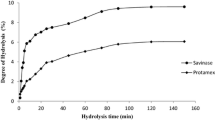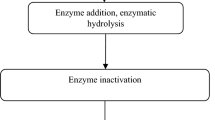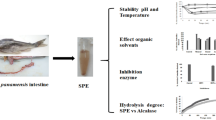Abstract
European eel proteins hydrolysates (EPHs) were produced from A. anguilla muscle protein and protein isolate using Purafect®, goby crude proteases and B. invictae proteases. EPHs had high protein contents and displayed diverse molecular mass distributions. Muscle protein hydrolysates (MPHs) and protein isolate hydrolysates (PIHs) obtained both by Purafect® had the highest antibacterial activity. PIHs obtained by B. invictae proteases had the highest emulsifying stability. MPHs and PIHs obtained by goby proteases and PIHs obtained by B. invictae proteases had higher chelating effects. MPHs obtained by B. invictae proteases and PIHs obtained by Purafect® had the highest ability to prevent bleaching of β-carotene at 4 mg/ml (96.68% and 93.66% respectively). The maltodextrin-muscle protein hydrolysates dispersions were totally stable by the creaming index and the zeta potential values (−36.73 and −42.53 mV) compared to the maltodextrin-protein isolate hydrolysates dispersions and had the best electrosprayability approving the best ability to form microcapsules.





Similar content being viewed by others
References
Adler-Nissen J (1986) A review of food hydrolysis specific areas. In: Adler-Nissen J (ed) Enzymic hydrolysis of food proteins. Elsevier Applied Science Publishers, Copenhagen, pp 57–109
Ahn CB, Cho YS, Je JY (2015) Purification and anti-inflammatory action of tripeptide from salmon pectoral fin byproduct protein hydrolysate. Food Chem 168:151–156
AOAC (2000) Official methods of analysis, 17th edn. Association of Official Analytical Chemists, Washington, DC
Ben Salem I, Sghaier H, Trifi H, Héni S, Khwaldia K, Saidi M, Landoulsi A (2011) Isolation and characterization of a novel Micrococcus strain for bioremediation of strontium inradioactive residues. Afr J Microbiol Res 6:851–858
Berghe VA, Vlieinck AJ (1991) Screening methods for antibacterial and antiviral agents from higher plants. Method Plant Biochem 6:47–68
Bersuder P, Hole M, Smith G (1998) Antioxidants from a heated histidine–glucose model system I. Investigation of the antioxidant role of histidine and isolation of antioxidants by high performance liquid chromatography. J Am Oil Chem Soc 75:181–187
Betty M, Awuor OL, Kirwa ME, Jackim MF (2014) Antioxidative and functional properties of Rastrineobolaargentea (Dagaa) fish protein hydrolysate. Discourse Int J Agric Food Sci 2:180–189
Chi C, Cao Z, Wang B, Hu F, Li Z, Zhang B (2014) Antioxidant and functional properties of collagen hydrolysates from Spanish mackerel skin as influenced by average molecular weight. J Mol 19:11211–11230
Chronakis IS (2010) Micro-/nano-fibers by electrospinning technology: processing, properties and applications. Micro Manufact Eng Technol:264–286
Decker EA, Welch B (1990) Role of ferritin as a lipid oxidation catalyst in muscle food. J Agric Food Chem 38:674–677
Desai KGH, Park HJ (2005) Recent developments in microencapsulation of food ingredients. Dry Technol 23:1361–1394
Elavarasan K, Naveen K, V., & Shamasundar, B. A. (2014) Antioxidant and functional properties of (FPH) from fresh water carp (Catlacatla) as influenced by the nature of enzyme. J Food Process Preserv 38:1207–1214
Galla NR, Pamidighantam PR, Akula S, Karakala B (2012) Functional properties and in vitro antioxidant activity of roe protein hydrolysates of Channastriatus and Labeohorita. J Food Chem 135:1479–1484
Gbogouri GA, Linder M, Fanni J, Parmentier M (2004) Influence of hydrolysis degree on the functional properties of salmon by products hydrolysates. J Food Sci 69:615–622
Geirsdottir M, Sigurgisladottir S, Hamaguchi PY, Thorkelsson G, Johannsson R, Kristinsson HG, Kristjansson MM (2010) Enzymatic hydrolysis of blue whiting (Micromesistius poutassou); functional and bioactive properties. J Food Sci 76:14–20
Halpin-Dohnalek MI, Marth EH (1989) Growth and production of enterotoxin A by Staphylococcus aureus in cream. J Dairy Sci 72:2266–2275
Hammami A, Hamdi M, Abdelhedi O, Jridi M, Nasri M, Bayoudh A (2016) Surfactant- and oxidant-stable alkaline proteases from Bacillus invictae: characterization and potential applications in chitin extraction and as a detergent additive. Int J Biol Macromol 96:272–281
Iglewski BH (1996) Chapter 27: Pseudomonas. In: Baron S (ed) Medical microbiology, 4th edn. University of Texas Medical Branch atfdéz Galveston, Galveston
Jafari SM, Assadpoor E, He Y, Bhandari B (2008) Encapsulation efficiency of foodflavours and oils during spray drying. Dry Technol 26:816–835
Kembhavi A, Kulkarni A, Pant A (1993) Salt-tolerant and thermostable alkaline proteases from Bacillus subtilis NCIM no. 64. J Appl Biochem Biotechnol 38:83–92
Klompong V, Benjakul S, Kantachote D, Shahidi F (2007) Antioxidative activity and functional properties of protein hydrolysate of yellow stripe trevally (Selaroidesleptolepis) as influenced by the degree of hydrolysis and enzyme type. J Food Chem 102:1317–1327
Koleva II, Van Beek TA, Linssen JPH, De Groot A, Evstatieva LN (2002) Screening of plant extracts for antioxidant activity: a comparative study on three testing methods. J Phytochem Anal 13:8–17
Kristinsson HG, Rasco BA (2000) Biochemical and functional properties of Atlantic salmon (Salmo salar) muscle proteins hydrolyzed with various alkaline proteases. J Agric Food Chem 48:657–666
Lajmi K, Gómez-Estacac J, Hammami M, Martínez-Alvarez O (2019) Upgrading collagenous smooth hound by-products: effect of hydrolysis conditions, in vitro gastrointestinal digestion and encapsulation on bioactive properties. Food Biosci 28:99–108
Lassoued I, Mora L, Nasri R, Aydi M, Toldrá F, Aristoy MC, Nasri M (2015) Characterization, antioxidative and ACE inhibitory properties of hydrolysates obtained from thornback ray (Raja clavata) muscle. J Proteome 128:458–468
Li Z, Wang B, Chi C, Gong Y, Luo H, Ding G (2013) Influence of average molecular weight on antioxidant and functional properties of cartilage collagen hydrolysates from Sphyrna lewini, Dasyatisakjei and Raja porosa. J Food Res Int 51:183–193
Lim LT, Mendes AC, Chronakis IS (2019) Electrospinning and electrospraying technologies for food applications. Adv Food Nutr Res:1–68
Lin MJY, Humbert ES, Sosulski FW (1974) Certain functional properties of sunflower meal products. J Food Sci 39:368–370
López-Córdoba A, Lagarón JM, Goyanes S (2016) Fabrication of electrospun and electrosprayed carriers for the delivery of bioactive food ingredients. Food Sci 1:–6
Mac-Connel AA, Eastwood A, Mitchell WD (1974) Physical characterization of vegetable foodstuffs that could influence bowel function. J Sci Food Agric 25:1457–1464
Mahmoud MI, Malone WT, Cordle CT (1992) Enzymatic hydrolysis of casein: effect of degree of hydrolysis on antigenicity and physical properties. J Food Sci 57:1223
Martínez-Alvarez O, Batista I, Ramos C, Montero P (2016) Enhancement of ACE and prolyl oligopeptidase inhibitory potency of protein hydrolysates from sardine and tuna by-products by simulated gastrointestinal digestion. Food Funct 7:2066–2073
Mohan A, Rajendran SRCK, He QS, Bazinet L, Udenigwe CC (2015) Encapsulation of food protein hydrolysates and peptides: a review. RSC Adv 5:79270–79278
Morales-Medina R, Tamm F, Guadix AM, Guadix EM, Drusch S (2016) Functional and antioxidant properties of hydrolysates of sardine (S. pilchardus) and horse mackerel (T. mediterraneus) for the microencapsulation of fish oil by spray-drying. Food Chem 194:1208–1216
Nalinanon S, Benjakul S, Kishimura H, Shahidi F (2011) Functionalities and antioxidant properties of protein hydrolysates from the muscle of ornate threadfin bream treated with pepsin from skipjack tuna. Food Chem 124:1354–1362
Nasri R, Chataigné G, Bougatef A, Chaâbouni MK, Dhulster P, Nasri M, Nedjar-Arroume N (2013) Novel angiotensin I-converting enzyme inhibitory peptides from enzymatic hydrolysates of goby (Zosterisessorophiocephalus) muscle proteins. J Proteome 91:444–452
Nasri R, Jridi M, Lassoued I, Jemil I, Ben Slama-Ben Salem R, Nasri M, Karra-Châabouni M (2014) The influence of the extent of enzymatic hydrolysis on antioxidative properties and ACE-inhibitory activities of protein hydrolysates from goby (Zosterisessor ophiocephalus) muscle. J Appl Biochem Biotechnol 173:1121–1134
Pearce KN, Kinsella JE (1978) Emulsifying properties of proteins: evaluation of a turbidimetric technique. J Agric Food Chem 26:716–723
Pérez-Masiá R, Lagaron JM, López-Rubio A (2014) Development and optimization of novel encapsulation structures of interest in functional foods through electrospraying. Food Bioprocess Technol 7:3236–3245
Pires C, Teixeiraa B, Cardosoa C, Mendesa R, Nunes ML, Batista I (2015) Cape hake protein hydrolysates prepared from alkaline solubilised proteins pre-treated with citric acid and calcium ions: functional properties and ACE inhibitory activity. J Pro Biochem 50:1006–1015
Qian ZJ, Jung QK, Kim SK (2008) Free radical scavenging activity of a novel antioxidative peptide purified from hydrolysate of bullfrog skin, Ranacatesbeiana Shaw. J Biores Technol 99:1690–1698
Sanchez CC, Patino JMR (2005) Interfacial, foaming and emulsifying characteristics of sodium caseinate as influenced by protein concentration in solution. J Food Hydrocoll 19:407–416
Schmitt C, Turgeon SL (2011) Protein/polysaccharide complexes and coacervates in food systems. Adv Colloid Interf Sci 167:63–70
Shahidi F, Han XQ, Synowiecki J (1995) Production and characteristics of protein hydrolysates from capelin (Mallotusvillosus). J Food Chem 53:285–293
Sripokar P, Benjakul S, Klomklao S (2019) Antioxidant and functional properties of protein hydrolysates obtained from starry triggerfish muscle using trypsin from albacore tuna liver. Biocatal Agric Biotechnol 17:447–454
Taghvaei M, Jafari SM, Mahoonak AS, Nikoo AM, Rahmanian N, Hajitabar J, Meshginfar N (2014) The effect of natural antioxidants extracted from plant and animalresources on the oxidative stability of soybean oil. LWT Food Sci Technol 56:124–130
Taheri A, Anvar SAA, Ahari H, Fogliano V (2013) Comparison the functional properties of protein hydrolysates from poultry by-products and rainbow trout (Onchorhynchus mykiss) viscera. Iran J Fish Sci 12:154–169
Taktak W, Nasri R, Hamdi M, Gomez-Mascaraque L, Rubio AL, Li S, Nasri M, Chaâbouni MK (2018) Physicochemical, textural, rheological and microstructural properties of protein isolate gels produced from European eel (Anguilla anguilla) by heat-induced gelation process. Food Hydrocoll 82:278–287
Tanuja S, Viji P, Zynudheen AA, Joshy CG (2012) Composition, functional properties and antioxidative activity of hydrolysates prepared from the frame meat of striped catfish (Pangasianodonhypophthalmus). Egypt J Biol 14:27–35
Tsumura K, Saito T, Tsuge K, Ashida H, Kugimiya W, Inouye K (2005) Functional properties of soy protein hydrolysates obtained by selective proteolysis. LWT Food Sci Technol 38:255–261
Van der Ven C, Gruppen H, de Bont DBA, Voragen AGJ (2002) Optimization of the angiotensin converting enzyme inhibition by whey protein hydrolysates using response surface methodology. Int Dairy J 12:813–820
Wen P, Zong MH, Linhardt RJ, Feng K, Wu H (2017) Electrospinning: a novel nano-encapsulation approach for bioactive compounds. Trends Food Sci Technol
Wiriyaphan C, Xiao H, Decker EA, Yong Sawatdigul J (2015) Chemical and cellular antioxidative properties of threadfin bream (Nemipterus spp.) surimi by product hydrolysates fractionated by ultrafiltration. J Food Chem 167:7–15
Wu HC, Chen HM, Shiau CY (2003) Free amino acids and peptides as related to antioxidant properties in protein hydrolysates of mackerel (Scomberaustriasicus). J Food Res Int 36:949–957
Yildirim A, Mavi A, Kara AA (2001) Determination of antioxidant and antimicrobial activities of Rumexcrispus L. extracts. J Agric Food Chem 49:4083–4089
Acknowledgements
This work was funded by the Ministry of Higher Education and Scientific Research-Tunisia. Authors would also like to thank the Central Support Service for Experimental Research (SCSIE) of the University of Valencia for the electronic microscopy service.
Funding
This study was sponsored by the Ministry of Higher Education and Scientific Research- Tunisia. Authors would also like to thank the Central Support Service for Experimental Research (SCSIE) of the University of Valencia for the electronic microscopy service.
Author information
Authors and Affiliations
Contributions
Wafa Taktak conceived of the study, formulated its design, coordinated the conduct of the study including data collection, performed the statistical analysis and interpreted the data, and drafted the manuscript; Marwa Hamdi and Laura G. Gomez-Mascaraque participated in the design of the study and helped to draft the manuscript; Rim Nasri participated in the design of the study, assisted in interpreting the data, and helped to draft the manuscript. Maha Karra-Chaâbouni, Rim Nasri and Moncef Nasri are the supervisor who read and approved the final manuscript.
Corresponding author
Ethics declarations
Conflict of interest
The authors report no conflicts of interest associated with this publication and there has been no significant financial support for this work that could have influenced its outcome.
Ethical Approval
We confirm that the manuscript has been read and approved by all named authors and that there are no other persons who satisfied the criteria for authorship but are not listed. We further confirm that the order of authors listed in the manuscript has been approved by all of us.
Research Involving Human and/or Animal Rights
This article does not contain any studies involving humain or animals performed by any of the authors.
Informed Consent
Informed Consent Informed consent was obtained from all individual participants included in the study.
Additional information
Publisher’s note
Springer Nature remains neutral with regard to jurisdictional claims in published maps and institutional affiliations.
Rights and permissions
About this article
Cite this article
Taktak, W., Nasri, R., López-Rubio, A. et al. Enzymatic Production of Novel European Eel Proteins Hydrolysates: Biological Activities, Techno-Functional Properties and Maltodextrin-Hydrolysates Efficient Electrosprayability. Int J Pept Res Ther 27, 1129–1148 (2021). https://doi.org/10.1007/s10989-020-10156-x
Accepted:
Published:
Issue Date:
DOI: https://doi.org/10.1007/s10989-020-10156-x




